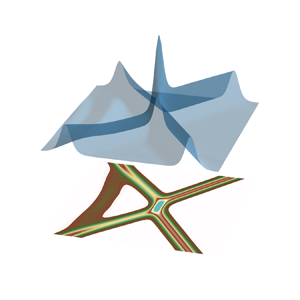Article contents
On diffraction and oblique interactions of horizontally two-dimensional internal solitary waves
Published online by Cambridge University Press: 11 February 2022
Abstract

In the context of three-dimensional oceanic internal waves, taking topographic effects into account, a modified Benney–Luke equation is proposed for describing internal wave–wave interactions on a sloping bottom. The derived equation is characterised by isotropy and bi-directional propagation, which are absent in the widely used Kadomtsev–Petviashvili equation. Indeed, these disparities are confirmed by numerical results of the diffraction of a truncated internal solitary wave and the evolution of a partially bent solitary wave. However, a good agreement between the numerical results of the modified Benney–Luke equation and those of the primitive equations confirms the validity of our simplified model. Because the stratification in a realistic ocean environment is usually continuous, in contrast to the assumption of a sharp density discontinuity used here, to maintain the kinematical equivalence, a layering scheme for determining the density and thickness of each layer from a continuous stratification is proposed. In addition, the occasionally observed but rarely examined X-shaped internal wave–wave interactions are shown to feature novel wave patterns, where topographic effects modulate the propagation speed, amplitude and waveform.
- Type
- JFM Papers
- Information
- Copyright
- © The Author(s), 2022. Published by Cambridge University Press
References
REFERENCES
- 8
- Cited by



